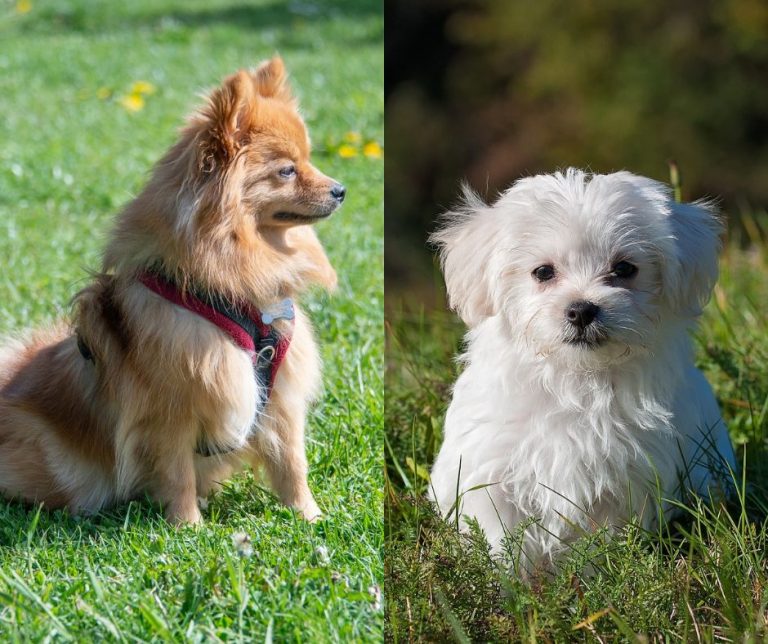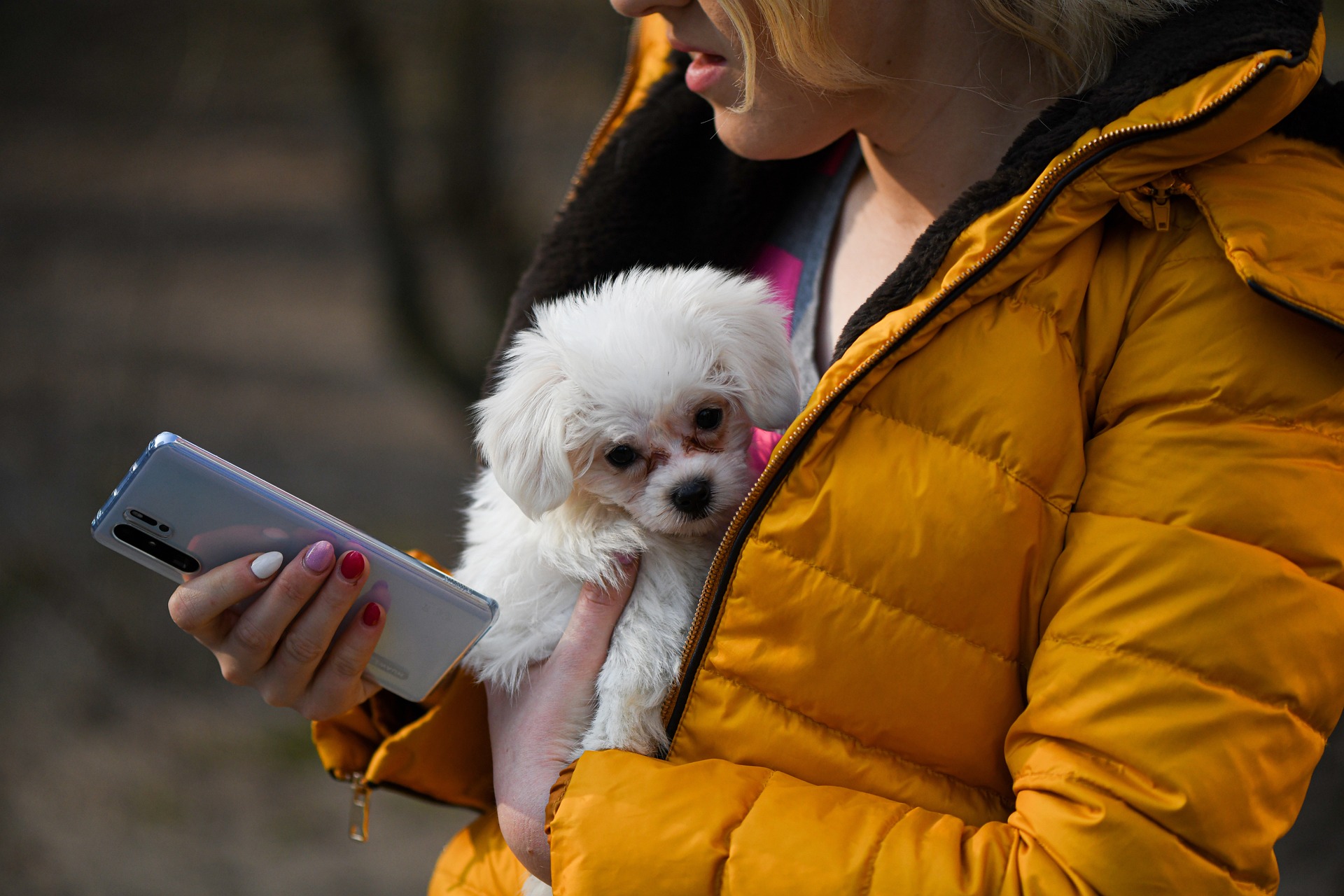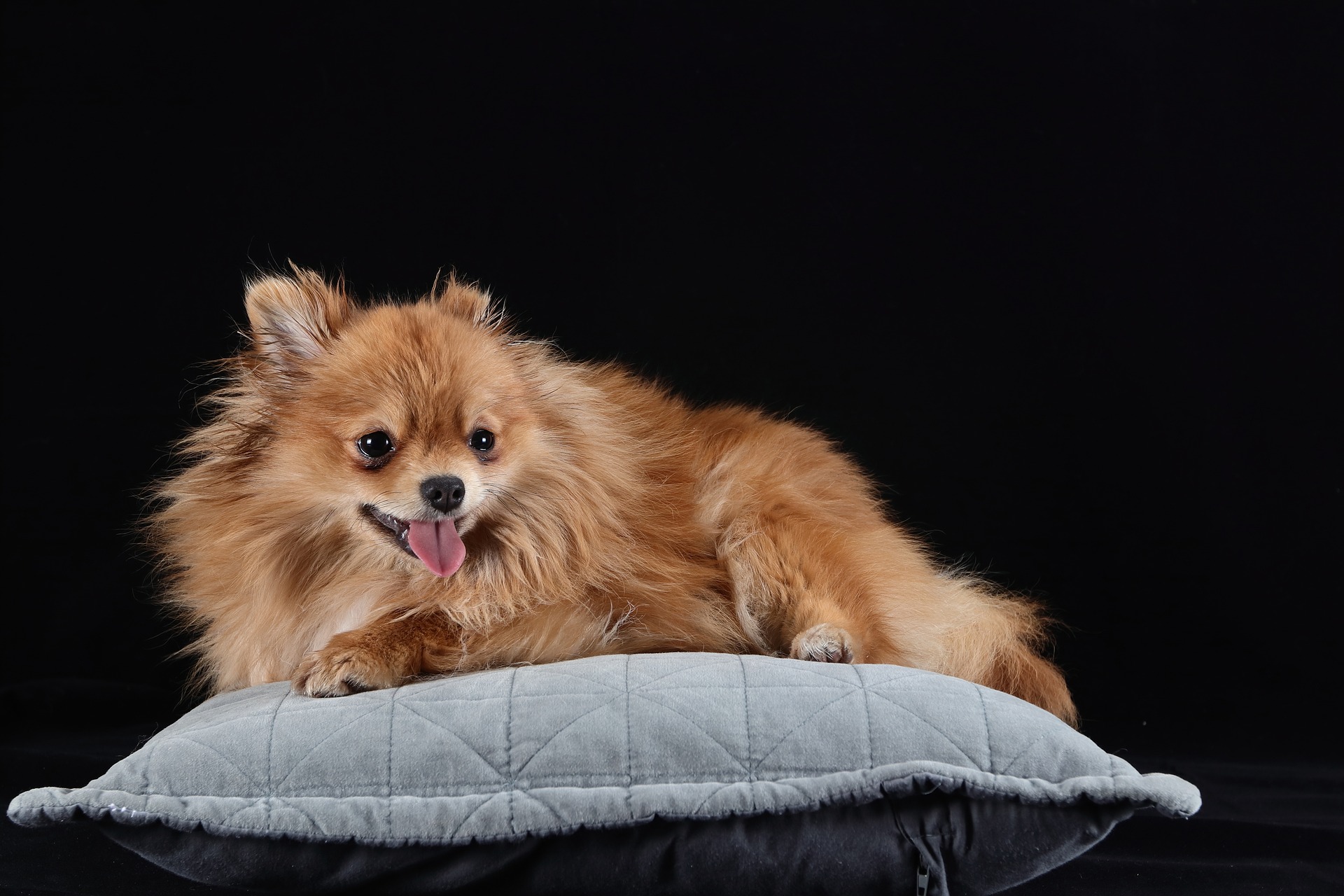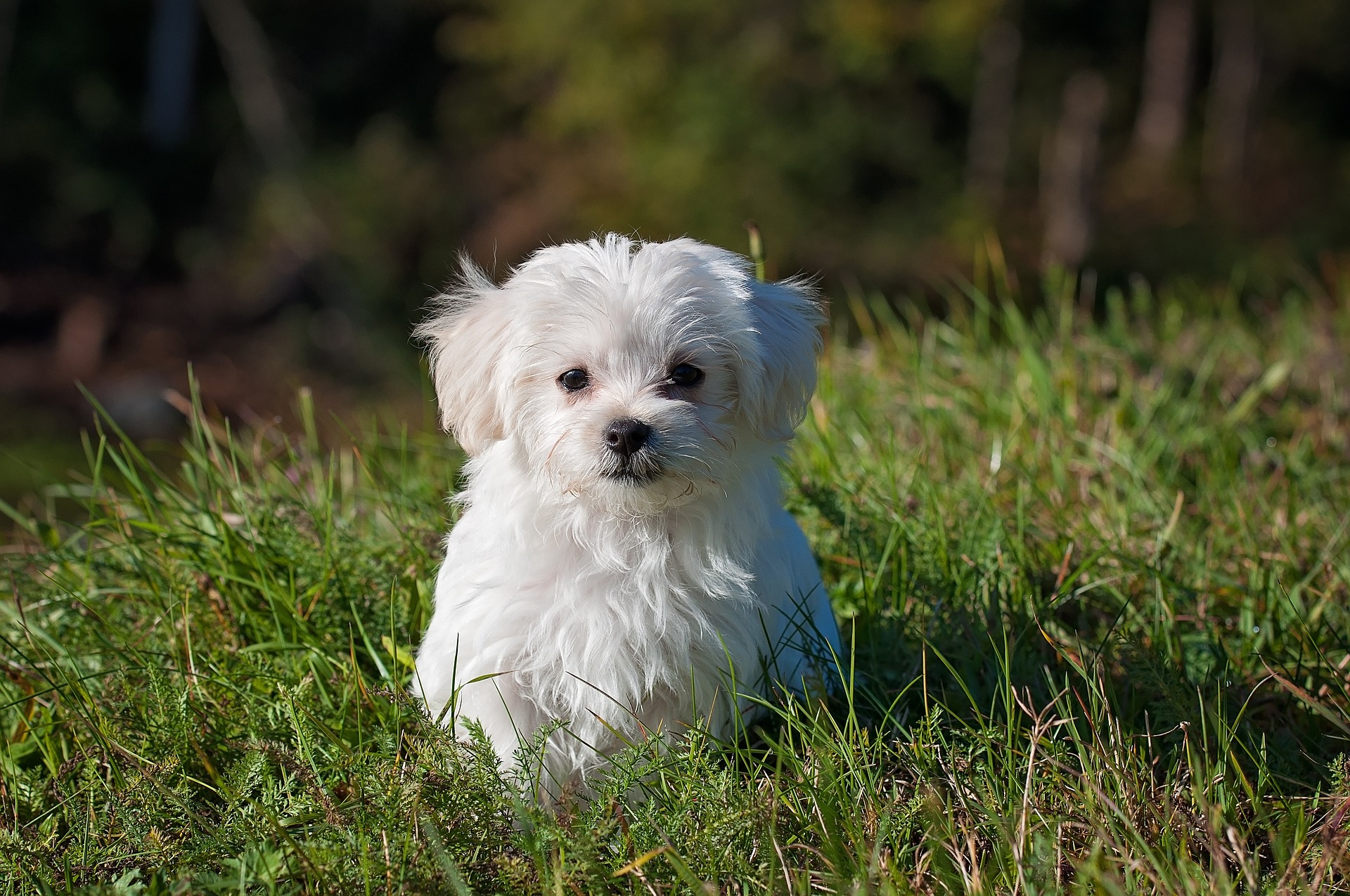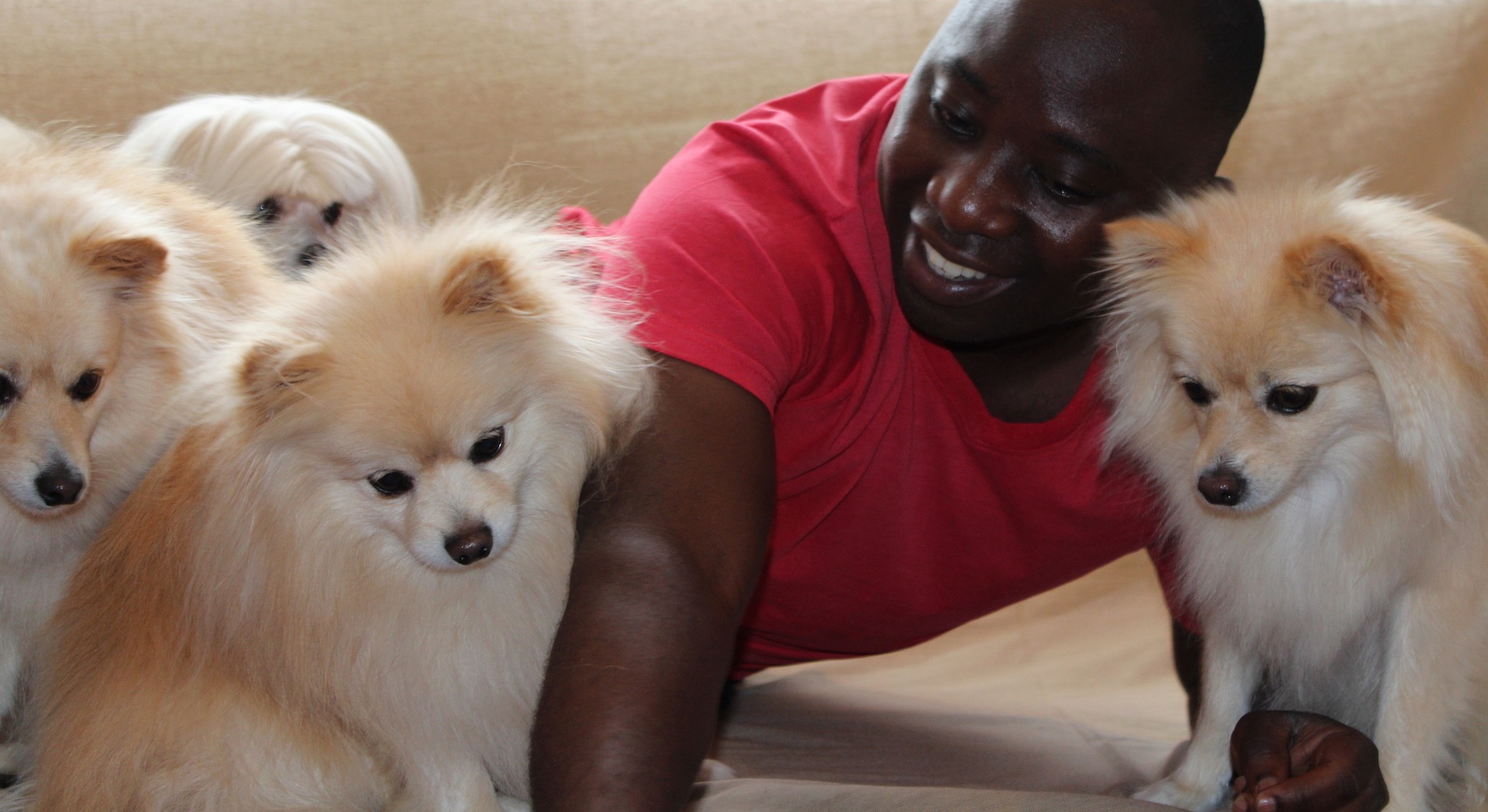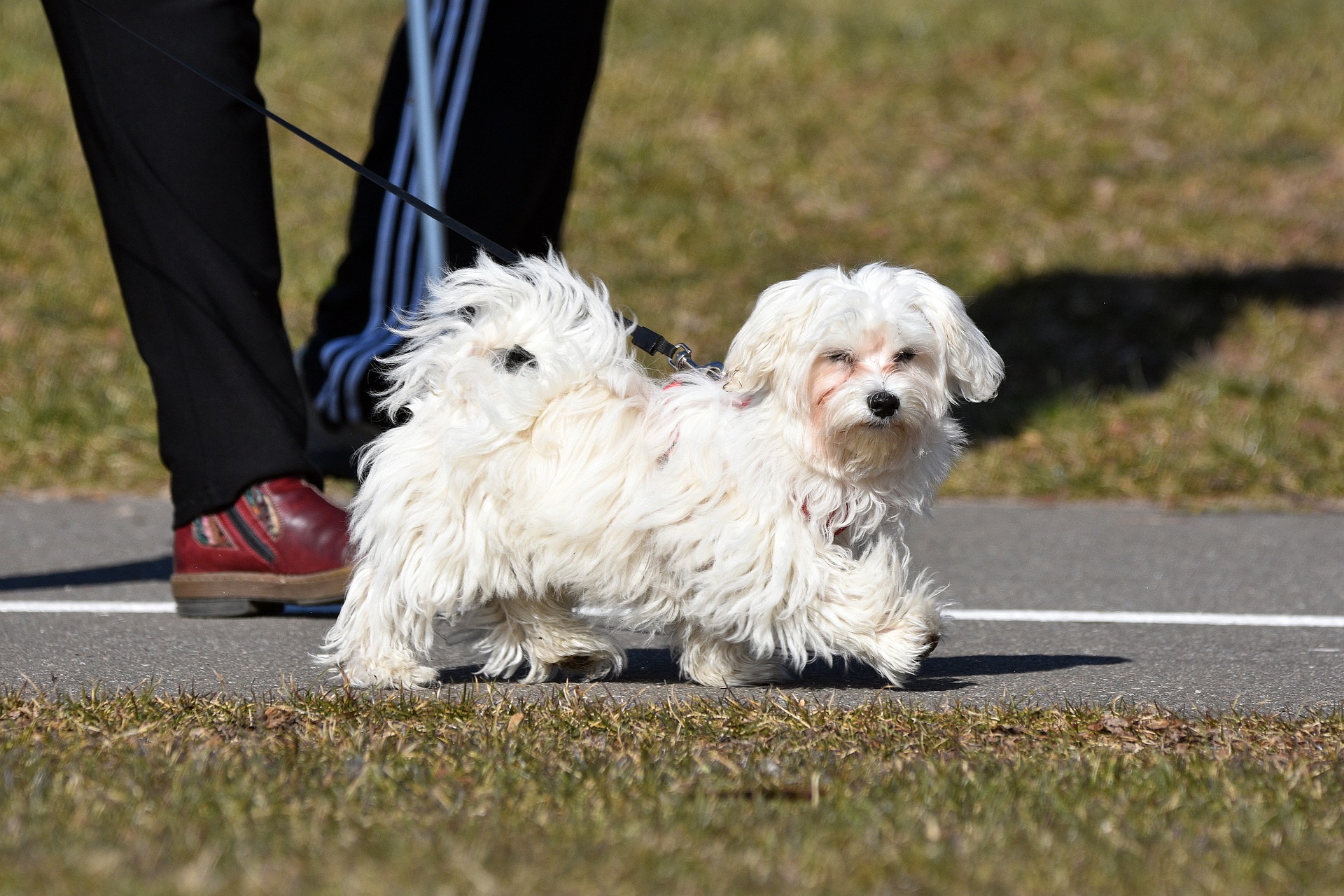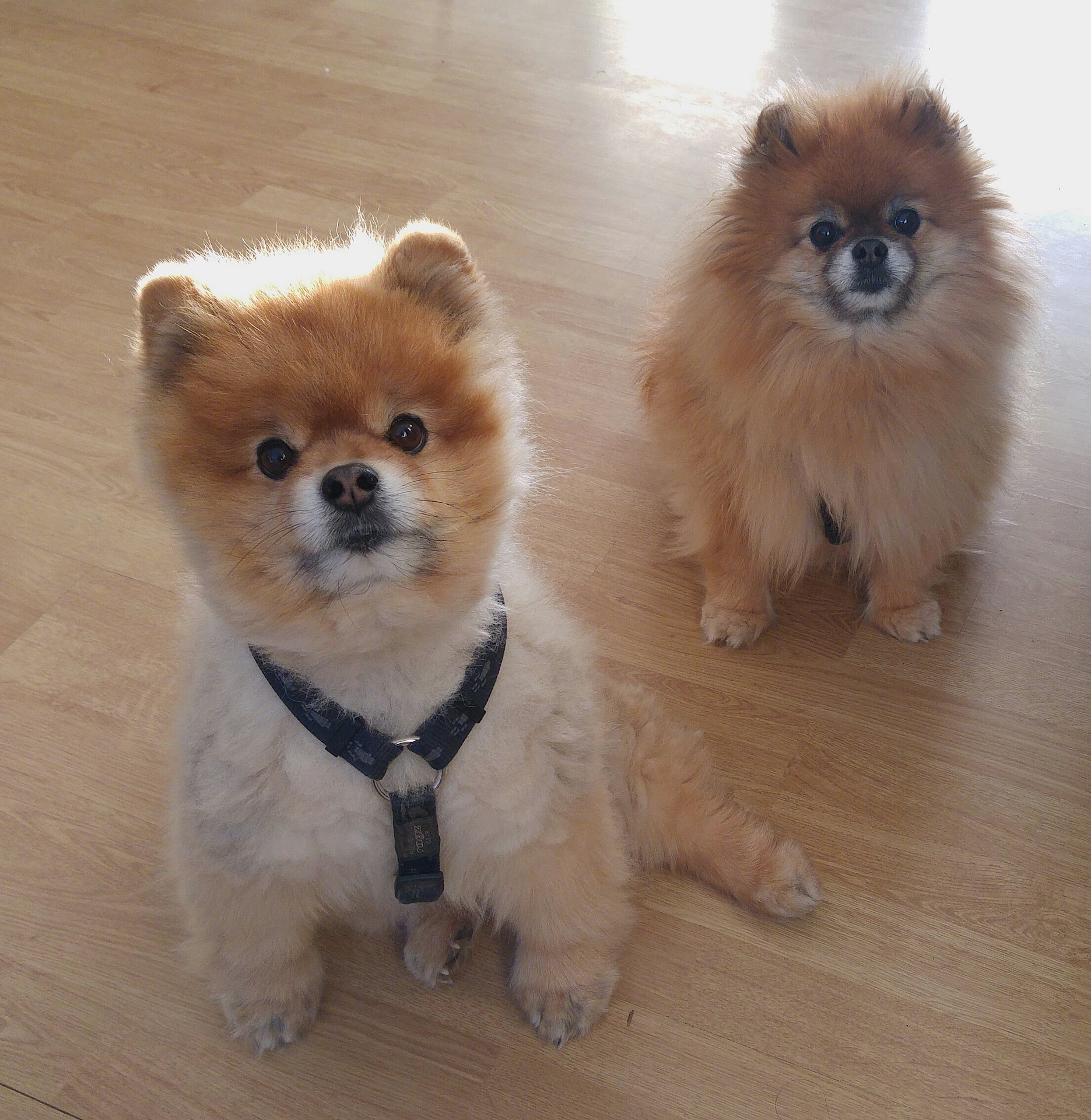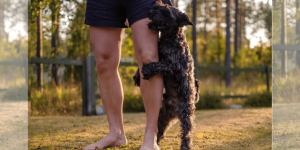When considering a furry companion to add warmth and joy to your home, the Maltese and Pomeranian breeds often come to the forefront for those who adore small dogs. These two breeds share the spotlight in the toy group but stand out for their distinct attributes.
The Maltese, with its pristine white coat and gentle demeanor, epitomizes elegance and has a history that traces back to ancient Mediterranean cultures. They are cherished for their companionship and seemingly aristocratic poise.
In contrast, the Pomeranian, with its foxy face and luxurious, puffed coat, reflects a vivacious spirit that is surprising for its compact body. Pomeranians are descendants of larger sled-pulling dogs from the Arctic and have been bred down to their present toy size, yet retaining a bold and confident personality. These dogs make a statement with their appearance as well as with their alert and energetic behavior.
So, let’s take a look at the Maltese vs Pomeranian dog breed comparison. Which is your better small dog companion? And if you cannot decide, you can get a Maltipom puppy. That is a mixed breed between these two.
Key Takeaways
- Maltese are elegant and poised, while Pomeranians are vivacious and confident
- Both breeds require regular grooming but differ in exercise and activity needs
- They are both toy breeds but come from different historical backgrounds
Origin and History
The Pomeranian and Maltese dogs are charming little canines with fascinating backstories that enrich their appeal.
Pomeranians originate from the Pomerania region, which is split between modern-day Germany and Poland. They began as larger sled-pulling dogs, akin to their other Spitz relatives. However, a particular royal fan, Queen Victoria, played a significant role in breeding them down to their current toy size. Her affection for smaller Poms influenced breeders to focus on miniaturization. They share same ancestry as the German Spitz. Many people mistake these two.
A vibrant bit of their history is that Queen Charlotte, Queen Victoria’s grandmother, also adored these fluffy companions, bringing them over to England when she married King George III.
Maltese dogs, with their signature silky white coats, share a rich history connected to the central Mediterranean area. Despite their name suggesting a sole connection to Malta, their origins might also link to nearby regions like Italy and Greece. They’ve been the companions of high society for thousands of years, celebrated for their elegant looks and charming demeanor.
The American Kennel Club (AKC) recognizes this breed as one of the utmost toy breeds, having seamlessly transitioned from royal laps to being beloved pets in homes across the globe.
Both dog breeds became well-established favorites, distinguished by their personalities and looks. The American Kennel Club acknowledges these breeds, having captivated the hearts of many with their unique traits and storied pasts. Here’s a quick look at their historical timeline:
- Pomeranian dogs: Initially used as sled dogs, they shrank in size thanks in part to Queen Victoria’s preference for small dog breeds
- Maltese: Central Mediterranean roots, always prized for companionship and status, now cherished household pets recognized by the AKC
Various twists and turns in their respective stories have led to the tiny, loving companions we know today.
Physical Characteristics
When one considers small, lovable dogs, the Pomeranian and Maltese breeds often come to mind. Both flaunt distinct aesthetics and require particular grooming attention due to their coat types. Understanding their physical traits helps prospective pet owners to better prepare for their care.
Appearance
The Pomeranian bears a resemblance to a tiny fox with its alert, pointy ears and bright eyes, sporting a confident look despite its small size. In contrast, the Maltese exudes a more regal air with a graceful neck and a gentle, yet aristocratic bearing. Its dark eyes and black button nose are set off by a striking, pure white coat which can give a majestic flair to their appearance.
Size and Weight
Both breeds are considered part of the toy group, denoting their manageable size:
- Pomeranian: They typically range from 3 to 7 pounds, making them a lightweight companion
- Maltese: This breed is similarly small, usually weighing under 7 pounds as well
Despite their petite statures, these dogs carry themselves with a presence that can fill a room.
Coat and Grooming
The Pomeranian has a double coat with a dense undercoat and a fluffy outer layer that requires regular grooming to prevent matting. Their fur can come in various colors and patterns, adding to their alluring, fluffy appearance.
In contrast, the Maltese showcases a beautiful white coat, often described as silky or glossy. This breed is known for its low tendency to shed, but their long fur is prone to matting and thus demands consistent grooming.
For both breeds, the key to maintaining their distinctive looks and preventing issues like tangling is a strict grooming routine. Regular brushing, baths, and trims will not only keep them looking their best, but also help to avoid potential skin problems.
Personality and Temperament
When considering Maltese vs Pomeranian as a new furry friend, dog owners should understand their distinct personalities and temperaments. It is a crucial aspect of selecting the best pet for your family. Both breeds have compelling traits, but their expressions of affection and interaction with families differ.
Temperament Traits
Pomeranians are known for their bold and spirited nature, often taking on the world with a larger-than-life attitude despite their small size. They are intelligent watchdogs, always alert and aware of their surroundings, which may lead to frequent barking. Their playful and friendly demeanor makes them charming companions, but they can be a bit stubborn during dog training sessions.
In contrast, Maltese dogs possess a gentle and affectionate temperament. They are sensitive and thrive on love and attention from their human companions. Although they can be lively and playful, Maltese dogs also show a more placid nature, which may be appealing for those seeking a calmer breed. While they have watchdog instincts, their barking tendency is notably lower than the Pomeranian’s.
Behavior with Families and Children
Pomeranians:
- Friendliness: They are affectionate with family members and can form strong bonds.
- Watchdog Nature: Their alert personality makes them good watchdogs, but this can lead to barking when around children or strangers.
Maltese:
- Suitability: They are generally a better choice for families with young children due to their gentle disposition.
- Playfulness: Both breeds enjoy playing, but Maltese dogs may be especially patient and sweet-natured, making them more compatible with kids.
Health and Care
When it comes to Pomeranians and Maltese, their adorable appearance is matched by specific health needs. They share a similar life expectancy but tend to face different health challenges.
Common Health Issues
Pomeranians are generally hardy, but they can have issues like patellar luxation, where the kneecap dislocates, and tracheal collapse which causes a honking cough. They are also at risk for progressive retinal atrophy, leading to blindness, and hypothyroidism, which affects metabolism. Here’s a brief list of health concerns for Pomeranians:
- Patellar Luxation
- Collapsed Trachea
- Progressive Retinal Atrophy
- Hypothyroidism
Maltese dogs have their own set of common health issues, such as patellar luxation as well. They might also suffer from hypoglycemia, particularly in stressful situations or if they miss meals. White Dog Shaker Syndrome, which causes tremors, is another condition that affects some Maltese. Their list includes:
- Patellar Luxation
- Hypoglycemia
- White Dog Shaker Syndrome
- Portosystemic Liver Shunt
Both breeds require regular vet check-ups to catch and manage these conditions early on.
Diet and Nutrition
A Pomeranian’s diet should be carefully monitored to prevent obesity, which can exacerbate hip dysplasia, a disorder where the hip joint doesn’t fit properly. This breed might also have allergies, which can be managed with a balanced diet. For Pomeranians:
- Avoid overfeeding to prevent obesity
- Watch out for dietary allergies
Maltese dogs also thrive on a balanced diet, though they should avoid too many treats to maintain a healthy weight. Regular, small meals can help manage the risk of hypoglycemia. Tips for a Maltese diet:
- Regular, small meals to prevent hypoglycemia
- A balanced diet to maintain an ideal weight
For both breeds, finding the right nutrition is key to a long and happy life. Always consult with a vet to tailor the diet to your dog’s needs, especially to account for any health concerns.
Training and Intelligence
When choosing between a Pomeranian and a Maltese, understanding their training needs and intelligence is essential. Both breeds exhibit distinct traits in dog training and their ability to learn.
Intelligent Deeds
Pomeranians and Maltese are known for their bright minds, often surprising their owners with their clever antics. The Pomeranian is alert and possesses an impressive aptitude for learning tricks, thriving on mental stimulation. They can master tasks such as fetching items or navigating simple obstacle courses. In contrast, the Maltese displays its intelligence through eagerness to please, making it quite responsive during obedience exercises. They are known to pick up on commands with a bit more patience.
Training Tips
Training a Pomeranian or a Maltese requires consistency, patience, and abundant positive reinforcement.
- Pomeranians have a propensity for being independent, which may require a firm but gentle approach. Here’s a helpful structure to consider:
- Use short training sessions to keep them engaged
- Incorporate play to make learning more enjoyable
- Be patient as they may exhibit stubbornness
- Maltese dogs, on the other hand, might need:
- Regular socialization from a young age to develop their friendly nature
- Positive rewards like treats or praise to motivate and reinforce desired behavior
- Gentle guidance as they can be sensitive to harsh methods
Exercise and Activity Levels
When it comes to keeping a Pomeranian or Maltese happy and healthy, understanding their need for exercise and suitable activities is key. Both breeds enjoy playfulness but their required energy outlets vary, highlighting the importance of tuning into their unique lifestyles.
Exercise Needs
Pomeranians are small but energetic dogs. They benefit from brief, daily exercise sessions.
A solid 30 minutes of activity—like walks or spirited playtime—usually suffices to meet their exercise requirements. Despite their small size, they have a considerable amount of energy and love to be active.
On the flip side, Maltese dogs often have a more laid-back energy level. They typically require a similar amount of exercise, often getting by with about 20 to 30 minutes each day.
The Maltese’s exercise can include leisurely walks and gentle play. They cherish mental stimulation just as much as physical activity, so puzzle toys and games of fetch inside can benefit them greatly.
Indoor and Outdoor Activities
Indoors, both Pomeranians and Maltese appreciate a variety of games that tap into their playful nature and intelligence.
For instance, a quick game of hide and seek with treats can provide mental stimulation and keep them engaged. Indoor play is crucial especially when the weather isn’t conducive to outdoor adventures.
For outdoor fun, both breeds enjoy a daily walk.
Pomeranians might lean towards more vigorous activities like chasing a ball, while Maltese could prefer a calm stroll in the park. However, owners should always pay attention to their pet’s response to activities; some dogs might surprise you with their preference for either more or less energetic play.
Living Conditions
When deciding if a Pomeranian or Maltese is the right fit for your home, it’s important to consider their adaptability and suitability for apartment living. Both breeds make wonderful companions but have different needs that can influence their happiness in various living environments.
Adapting to Environments
Pomeranians, with their spunky nature, tend to be quite adaptable. They form strong bonds with their families and can thrive in diverse settings as long as they have enough stimulation. However, their energy levels mean they do best with regular opportunities to play and exercise.
On the other hand, Maltese dogs are known for their gentle demeanor. They are sociable but may prefer quieter environments.
Despite their calm nature, Maltese dogs still appreciate playtime and interaction, which helps them adjust to their living situation, whether it’s a bustling household or a more serene setting. These two companion dogs are in the same group as Shih Tzu, French Bulldog, Boston Terrier, Bichon Frise, and other small toy dog breeds.
Apartment Living
Apartment dwellers will find both Pomeranians and Maltese to be suitable breeds, as these small dogs don’t require a backyard to be happy. They do, however, need to be taken out for regular walks and socialization.
- Pomeranians:
- Can be vocal, which might be an issue for apartment noise levels
- High-energy, requiring regular playtime even within smaller spaces
- Maltese:
- Typically quieter, a bonus for close-quarter living
- They have moderate exercise needs that are well-suited to apartment life
Grooming and Maintenance
Choosing between a Pomeranian and a Maltese isn’t just about their charming looks; it’s about their grooming needs, too. Getting to know the grooming routine and shedding characteristics will help maintain their trademark fluff and sparkle.
Grooming Routines
For those who cherish pristine, white coats, the Maltese is an icon. Their silky white fur demands daily brushing to prevent matting and tangles. Their grooming regimen should be thorough; some owners embrace the “puppy cut” as a low-maintenance alternative.
Pomeranians, with their dense double coats, require regular brushing, a few times a week, to manage shedding and keep their fur looking voluminous and healthy. Their grooming needs extend beyond brushing to include regular baths and the occasional trim to keep their fur in shape.
Shedding and Cleaning
Even though Pomeranians have more fur, their shedding is usually contained with regular grooming.
They’re known for “blowing their coat” seasonally. This entails a significant increase in shedding.
Maltese are often celebrated for their minimal shedding. This is a relief for owners who prefer less fur around the home. The Maltese dog breed is considered to be a hypoallergenic dog. They almost do not shed. The same cannot be said for the Pomeranian dog breed.
They do, however, require frequent bathing to maintain the dazzling white coat that they’re famous for.
Keeping their white hair sparkling means being vigilant with cleaning, as it easily displays any dirt or stains. Pomeranian dogs can be hypoallergenic as well. But that happens only when they are mixed with another breed, like the Poodle. The Pomapoo is one of the most famous Pomeranian mixes.

